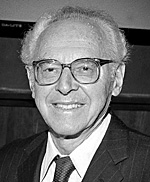Maurice Goldhaber
DOI: 10.1063/PT.3.1304
Maurice Goldhaber, a seminal contributor to nuclear and particle physics and director of Brookhaven National Laboratory (BNL) from 1961 to 1973, died at the age of 100 on 11 May 2011 after a short illness.
Maurice was born in Lemberg, Austria, on 18 April 1911. He received his gymnasium education in Saxony before going to the University of Berlin, where Lise Meitner taught his first course in nuclear physics. In 1933, with recommendations from Erwin Schrödinger and Max von Laue, he was accepted by Ernest Rutherford as a student at the Cavendish Laboratory.
He quickly made his first major contribution when he suggested to James Chadwick, who had discovered the neutron a year earlier, that the deuteron could be disintegrated by high-energy photons. The backstory, which Maurice often told, illustrates the special way he operated throughout his career. In the spring of 1933, while still a student in Berlin, he read that Gilbert Lewis had made a gram of heavy water. Maurice, who kept dated notebooks of his ideas, jotted down “What can you do with heavy water?” One of his ideas was that gamma rays could disintegrate the deuteron. He knew it was a good idea, told no one, but did not stop thinking about it.
Less than a year later, when he went to Chadwick to seek information about lithium reactions, he suggested his photodisintegration idea. Chadwick was uninterested but “caught fire” when Maurice told him, “You get the neutron mass out of it.” Six weeks later, when Maurice sought Chadwick’s approval of his first publishable paper, “Spontaneous emission of neutrons by artificially produced radioactive bodies,” Chadwick asked whether he was the man who suggested the photodisintegration. On getting a yes, Chadwick said, “It worked last night. Would you like to work with me on it?” A year later Chadwick and Maurice published the first accurate measurement of the mass of the neutron. (Most of the quotations here are from Maurice’s oral history interview with the American Institute of Physics, http://www.aip.org/history/ohilist/4632.html
Maurice earned his PhD in physics at Cambridge University in 1936, at a time when jobs for physicists were scarce. He was still on a fellowship when he visited the US in 1938. Friends who preceded him there recommended he accept a faculty position at the University of Illinois. While at the university, he built a strong reputation for creative experiments that covered a wide range of nuclear problems; they were conducted at many laboratories, including BNL, where he worked for several summers. He joined BNL in 1950, in part because of its bountiful nuclear facilities and in part because it had a position for his wife, Gertrude Scharff Goldhaber, a creative nuclear physicist in her own right who could not get a paid position at Illinois because of nepotism rules.
Maurice was a vital contributor to the growth and development of many areas of research at BNL. He was valued for his far-ranging interests, encyclopedic knowledge of nuclear and particle physics, willingness to listen, and openness to share with others his carefully thought-through ideas for experimental or theoretical exposition. Maurice focused on forefront issues, especially if they involved neutral particles, which he said “are very clean.” Gamma rays, neutrons, and neutrinos “come in and they don’t ionize until something happens.”
From his earliest experiments, Maurice always considered the spin aspects. They had given him important insights in his work at Cavendish and were essential to his successful classification of nuclear isomers using the shell model. Those recurring themes came together in 1958 when Maurice, Andrew Sunyar, and one of us (Grodzins) used a small tabletop apparatus and a gamma-ray signature to determine the helicity of the neutrino. Maurice’s vital contribution was his insight that the unique combination of spins involved in the europium-to-samarium decay process, together with the simple kinematics, enabled an unambiguous determination of the neutrino helicity.
Maurice’s exceptionally productive career, from his first publication in 1933 to his final one written with his son Alfred for the May 2011 issue of Physics Today (page 40)
A memorable trait of Maurice’s was his love for aphorisms and puns. He often said, “Physics teaches old things to new people.” In talking about the Irvine-Michigan-Brookhaven experimental search for proton decay, he pointed out that you could get an estimate of the proton’s lifetime because if it were too short, “you could feel it in your bones.”
Maurice was a superb laboratory director. With style, charm, and wit he initiated and presided over an extraordinary period of scientific productivity at BNL. Research during his tenure resulted in major discoveries in physics, three of which eventually garnered Nobel Prizes. Perhaps as valued as his other contributions was Maurice’s immersion in science discussions, which he was willing to do anywhere and with anyone; he would ask the telling question, give new insights into the issues, and always be helpful and very much to the point. His immense impact at the laboratory is a lasting legacy.

Maurice Goldhaber
BROOKHAVEN NATIONAL LABORATORY

More about the Authors
Peter D. Bond. Brookhaven National Laboratory Upton, New York.
Lee Grodzins. American Science & Engineering Billerica, Massachusetts.




